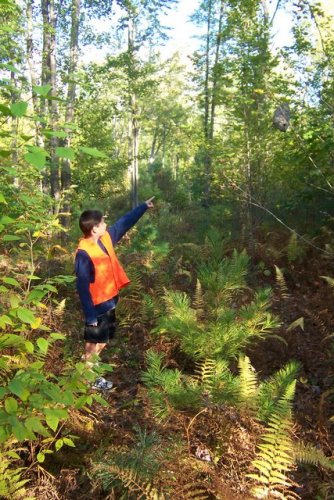When my 10-year-old grandson, Jay, and I were hiking in the woods, we saw a white-faced hornet's nest high in a tree and several days later we had a 22 inch snowfall. This made me think of the ancient adage, “See how high the hornet's nest; 'twill tell how high the snow will rest.” This folk-lore reminds us how old-timers tried to find clues in nature to determine the severity of the forthcoming winter, but I wondered about its truth.
White-faced hornets are so named because of their white facial markings. Also called bald-faced hornets, these social wasps live throughout North America where they are native. A fertilized queen that has hibernated in the ground or in a log during the winter will select the site for her new colony in the spring. Like all the workers after her, she will use chewed wood fibers mixed with the starch of her saliva to produce a paper-like material to build the nest. (Hornets are the world's first paper makers.) In the nest, she will make small cubicles and into each one she will lay an egg, from which will develop a larva. She will kill insects to feed to these larvae which will grow into sterile females, becoming the first workers of the colony.
The queen will now spent her time and energy laying eggs and the workers will take over the duties of expanding the nest, feeding the larvae and protecting the nest from intruders. Although the workers will capture many insects to feed the larvae, they themselves will forge on flower nectar and fruit pulp. After several generations of workers, the mature colony may have as many as 600 workers. Only the female workers can sting, and unlike honey bees, they have smooth stingers and can sting repeatedly. Their venom can elicit a life threatening allergic reaction in some inpiduals.
At the end of the summer, by the magic of nature, the queen will lay eggs that will produce fertile males and females. These will leave the nest to mate, and the fertilized females will hibernate while all others in the colony will perish in the cold of winter. The nest will not be reused. In spring the fertilized queens will come out of hibernation to select sites for their new colonies and the life cycle will be repeated.
Each year when winter arrives in earnest, the nests of hornets are ghost towns and are not affected by the amount of snow that falls. So it really does not matter to the deceased hornets how high the nest is off the ground. While there is no scientific validity to the folk-lore about the height of hornet nests forecasting the amount of snowfall expected in the winter, it is fun to imagine a time when all the weather prognostic evidence available to our pioneer families was in the subtle signs of nature.






















